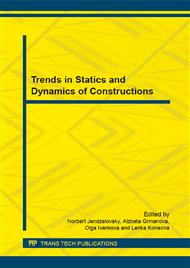p.180
p.185
p.192
p.200
p.206
p.212
p.218
p.225
p.229
Consideration of Cover Layer of Concrete by Nonlinear Sectional Analysis
Abstract:
Paper discusses the implementation of sectional analysis in a custom program developed by authors. The program is devoted to nonlinear analysis of reinforced concrete frames. Analysis consists of two interrelated iterative procedures, global frame analysis and sectional analysis. The latter works with the discretized cross section into finite number of concrete fibres and reinforcement layers. Each fibre is analysed separately to determine axial stresses on them. However, equilibrium and compatibility requirements are satisfied for the cross section as a whole. For determination of stresses on fibres is used Disturbed Stress Field Theory (DSFM) model. Paper summarizes the concept of the global and sectional analysis and DSFM. Finally it shows the proposed implementation of cross section discretization for the sectional analysis in respect with consideration of the cover layer if the concrete.
Info:
Periodical:
Pages:
206-211
Citation:
Online since:
June 2015
Authors:
Price:
Сopyright:
© 2015 Trans Tech Publications Ltd. All Rights Reserved
Share:
Citation:


